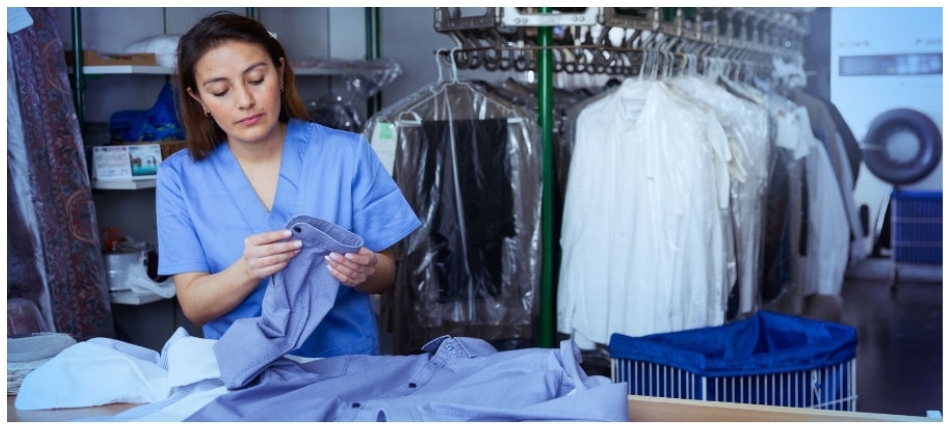How to Dry Clean Garments/Clothes at Home

Easily dry clean clothes at home using a home dry cleaning kit, steam, or spot cleaning methods. Check fabric labels, use a gentle detergent, and air-dry delicate garments properly to maintain their quality and freshness.
Step-by-Step Guide on Home Dry Cleaning
To the average person, the difference between dry cleaning and regular washing is far from obvious.particular service is laundries services and routine laundry services will save your cash, time, and preserve the longevity of your garments. In this guide, We’ll also discuss the how to dry clean clothes at home, and when to choose professional services over home cleaning.
The main advantage of home dry cleaning is that it is affordable. While professional services use specialized solvents and equipment, home dry cleaning kits allow you to clean clothes at home. A dry cleaning sheet or bag is used to remove dryer dirt and odors. Home dry cleaning is usually a good option for lightly soiled, stained, and plain clothes. For heavier clothing or stubborn stains, a professional dry cleaning service should be used.
When people need to have their clothes dry cleaned, the first thing they think about is the cost. Professional dry cleaning services can cost a few pounds for simple clothing, including shirts and pants, but can be much more expensive for heavier fabrics, such as suits and coats. Cost can also vary depending on location and the skill of the cleaner.

Preparing to Dry Clean
Identify Lightly Soiled Versus Heavily Soiled Clothing
Lightly soiled clothes should be separated from heavily soiled clothes. Lightly soiled clothes worn for a short period of time should be dry-cleaned at home. However, heavily soiled clothes, such as those with grease stains, oil stains, or makeup stains, should be taken to a professional dry cleaner. Their experts will remove tough stains without damaging the fabric.
Identify Appropriate Clothing for Home Dry Cleaning
When you start dry cleaning, prepare your clothes properly. Separate the clothes that can be dry-cleaned at home. To maintain the quality of your clothes, not all clothes should be dry-cleaned at home. Clothes that are safe for dry-cleaning at home include polyester, nylon, and cotton blends. These fabrics are durable and heat-resistant, making them suitable for home cleaning.
Dry Cleaning Process Start
Grouping by Color & Avoiding Overcrowding
Loading of the dry cleaning bags is the beginning of the dry cleaning process, this is done with precision based on color grouping. Clothes should be sorted to avoid dye bleeding between items by color. Dark clothes should be separated from lights.
For example: Dark clothes like black, navy, and dark red need to be washed on their own, away from whites, beiges, and pastels. You can wash medium colors (gray, olive green, burgundy) and bright colors (red, orange, yellow) so avoid washing them together in a single load and washing with white fabrics.
Do not overfill the bag as you want the clothes to have room to move so that they are cleaned better, and the solvent can circulate better allowing stains to be removed more effectively
NB: If you take a professional Dry cleaning service in London like Nearest Laundry you don’t need to sort your dress by color, Because their expert team takes your clothes and separates them
What Are Dry Cleaning Sheets Good For Stain and Freshener Removal
They then slip a dry cleaning sheet into the bag. These sheets are supposed to help pull up dirt and odors,refresh the fabric, and leave a nice scent. If you’re using home dry cleaning kit, is a crucial step to getting a fresh and clean result.
Establishing Proper Temperature Zones and Not Overheating Drying
- Once the clothes are in and the sheet is in place, it’s time to run the dryer. The using the correct heat settings for the fabric, the dryer should delicate avoid drying delicate fabrics like silk or wool on high heat, but heavier fabrics can tolerate medium heat.
- Careful not to over-dry, which could compromise the fibers, shrinkage, or weakening of the fabric. You’ll want to take the garments off a bit wet and let them towel dry for a smoother, safer finish.
Last Step – Inspecting for Spots and Spot Cleaning
After the drying process, it’s time for the final touch. Carefully inspect your wear for the stains that may be left on the clothes. If you do find them, don’t fret – they can be treated with stain remover. For any tough stains that didn’t come out in the initial cleaning process, apply the remover and follow the product directions to penetrate the stain. Re-running the cleaning process can help with stubborn stains.
Ironing and Steaming to Achieve a Professional Finish
Once you’ve rinsed any stains out of your clothes, the next step is to iron or steam them to a clean, professional-looking result. Ironing works wonders on structured pieces like shirts, blazers, and pants and steaming works best with delicate fabrics like silk or wool. Steaming helps to release wrinkles without direct application of heat, safeguarding the fabric from potential damage. Make sure to set the right temperature for the type of fabric you are using so you don’t risk shrinking it or burning the fabe, leaving you with a duvet that’s not useful at all. your clothes crisp and fresh.
When to Leave to the Professionals Dry Cleaner
While home dry cleaning kits can be a great solution for less cleaning needs, there are some situations where it is best to hire a professional Dry Cleaning Service in London. If your clothes are made of delicate clothes, heavy dirty or complex spots, a professional cleaner is the best. Professional cleanser has the ability to clean large objects such as coats and comfort, which may be too heavy for home dry cleaning.
In addition, if you have complex details such as embroidery, pearls or lace, it is safe to leave experts. The delicate nature of these objects can easily be damaged by incorrect care. Pieces that need the care of a professional dry cleaner to ensure their quality and longevity.
How to find an experienced dry cleaner
Reputation and Reviews: Find a dry cleaner with good customer feedback and a solid reputation.
Level of Cleaning: Make sure that they are following best cleaning practices, so that the cleaning methods are appropriate for your fabrics. Opt for a cleaner designed for delicate clothing and stubborn stains.
Turnaround: Also consider the turnaround time. When you need to get your clothes clean in a hurry, a laundromat that provides same-day delivery.
Pricing and Transparency: A breakdown of the pricing with no hidden costs A professional service should include disclosure of its prices, along with a breakdown of services.
Convenience and Accessibility: Select a service that provides easy pickup and delivery. Nearest Laundry even allows for free pickup and delivery, so you can get your laundry done without ever leaving your house,more than ever, to get your clothes cleaned without leaving home
The process of dry cleaning helps in the cleaning of fragile and delicate fabrics, it is done by using chemical solvents rather than using water. A dry cleaning service is perfect for fabrics that can’t get wet, such as silk, wool and certain synthetics, as opposed to the traditional laundry service that requires water and detergent. The process consists of putting clothes in a machine filled with a solvent that lifts dirt and stains without shrinking or damaging the fabric.
Average Dry Cleaning Costs in London
The price of dry cleaning depends on a number of factors fabric type, garment complexity, and the dry cleaner’s rate plan. Here is a price range for items analyzed by a reputable laundry service in London
Factors Affecting Dry Cleaning Costs
- Fabric Type – Delicate fabrics like silk, wool, and cashmere are more expensive to clean.
- Garment Complexity – Beaded, sequined, or heavily lined clothing costs more.
- Stain Removal – Extra charges apply for tough stains like oil, wine, or ink.
|



